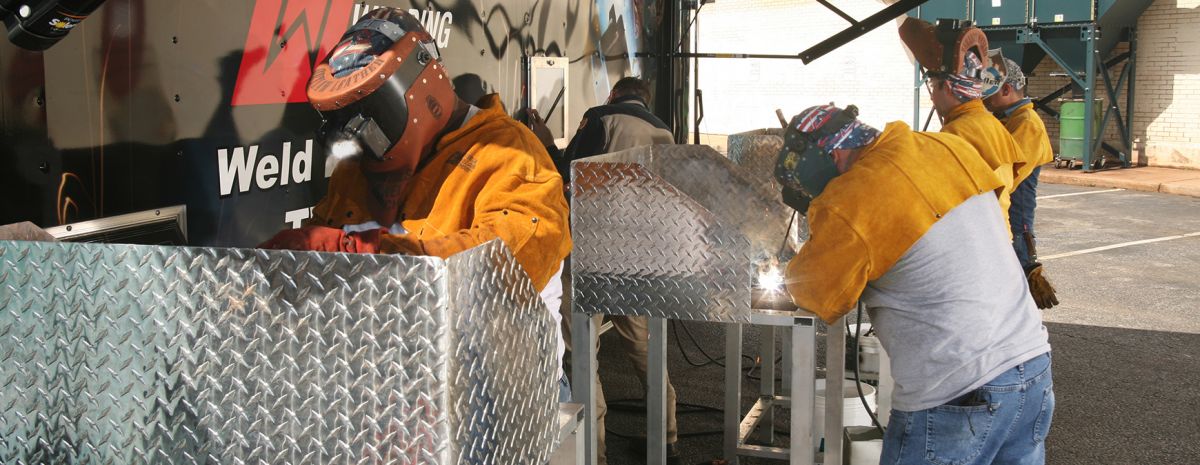TWS is a Great Training Option for Everyone
Learn more about how we can prepare you to advance your career.
Do you find it difficult to focus and learn in a traditional classroom setting? Are you able to process new information quicker when you’re moving around and staying active? If this sounds familiar, you might be a hands-on learner.1
A conventional learning environment might be keeping you from reaching your full potential. And since learning often extends beyond the classroom, you might even want to consider choosing a career where you can continue learning by doing.
Let’s take a closer look at what hands-on learning is and where you can find educational and professional opportunities matching this style.
What Is Hands-On Learning?
Kinesthetic learning, more commonly referred to as hands-on learning, describes the way some people acquire information and develop skills through physical engagement.1 It’s one of four different learning styles defined by the VARK system, with visual, auditory and reading being the three other methods. These categories were created to help students understand their preferences for more productive learning.2
Have You Considered a Career in the Skilled Trades?
Fill out the form to recieve a no obligation info packet.
Individuals who excel with hands-on learning often struggle in lecture-based settings. Their bodies need to be engaged just as much as their minds.1 Through kinesthetic learning, there’s a connection between what’s being learned and what the student is doing physically.1
Why Is Hands-On Learning Important?
Hands-on learning is important because it’s one of the most natural and effective ways for kinesthetic learners to develop new skills and memorize new information. It makes it easier for students to determine an educational path that best matches their learning skills.
But why is hands-on learning important for adults? Adults with a preference for hands-on learning might do better in training programs centered around kinesthetic learning, for example, trades school courses like welding training or electrician programs.
What Are Some Benefits of Being a Hands-On Learner?
If you have a preference for kinesthetic learning, you might have some important strengths that can help you excel both academically and professionally in the right setting.1 Here are just a few benefits of being a hands-on learner:
- Quick reflexes
- Excellent hand-eye coordination
- Fantastic motor memory
- High energy levels1
Some of these skills might come in handy if you decide to learn welding or another skilled trade.
Trade School vs. Community College: Where Can I Find Hands-On Learning?
Most colleges and universities use conventional learning methods, making it difficult for hands-on learners to succeed. Community colleges and trade schools are two alternatives that offer more kinesthetic opportunities to help students quickly develop the skills needed to prepare for entry-level jobs as a welder or electrician.3 But there are some important differences to consider.
Community colleges tend to lean towards the conventional learning style, with an emphasis on theories and lectures rather than strictly hands-on methods.3 These learning strategies are designed to help prepare students for jobs in specific fields, but much of the time is still dedicated to non-kinesthetic learning methods.3 That’s where trade schools are unique.
At vocational schools, hands-on learning is the main way students develop their skills.3 There are still some lectures, but the majority of time is spent doing what’s being learned.3 Trade schools are specifically designed to give students real-life experience in the field for which they’re training—whether welding, HVAC or electrical wiring.3
Instead of having students take courses unrelated to their career direction, trade schools are designed to develop skills in a specific field.3 This way, graduates have the skills and qualifications needed to start working in entry-level positions in their trade right away.3 This is just one of the many benefits of a trade career.
Exploring the Benefits of Vocational Education

For a long time, there’s been a misconception that the trades are for those who couldn’t make it at the collegiate level.4 Fortunately, this idea is starting to change as people start seeing vocational schools for what they really are: an alternative to college that provides preparation for potentially rewarding careers.4 One of the biggest motivators for people choosing the trades over college is the hands-on and in-person learning offered at vocational programs.
A StrataTech survey found 76% of people prefer in-person learning to online learning.5 Plus, 82% of respondents said it was important for them to learn in a small classroom where it’s possible to get to know other students and instructors.5 It was also found that 88% of people liked hands-on learning.5
These stats suggest a strong preference among students for hands-on, in-person learning. In some ways, the recent pandemic has highlighted this demand: 76% of students who were moved to online learning due to COVID-19 challenges say that in-person learning is extremely or very important.5 Many people want an education and career that’s hands-on and physical. Trade school programs can be a good place for kinesthetic learners to capitalize on their strengths.
Start Learning by Doing at Trade School
Does a hands-on learning environment sound like the right fit for you? Talk to a Tulsa Welding School rep to get started learning by doing today! Call 855-806-4921.
1https://www.thoughtco.com/the-kinesthetic-learning-style-321204
2https://www.indeed.com/career-advice/career-development/kinesthetic-learning-strategies
3https://study.com/blog/trade-school-vs-community-college-what-s-the-difference.htm
4https://careerkarma.com/blog/trade-school-vs-college/
5https://stratatech.com/wp-content/uploads/2021/10/2021-StrataTech-COVID-19-Pandemic-Survey.pdf







